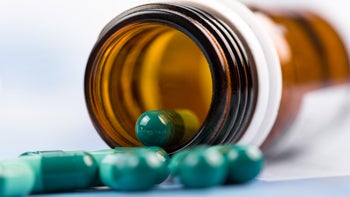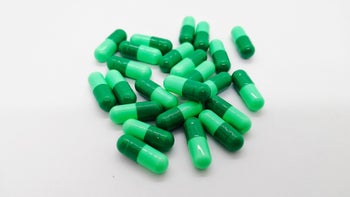
11 Cephalexin (Keflex) Side Effects You Should Know About
Key takeaways:
Cephalexin (Keflex) is an antibiotic used to treat a number of bacterial infections. It belongs to a class of antibiotics called cephalosporins.
The most common cephalexin side effects are diarrhea, nausea, and stomach pain. Headache, fatigue, and vaginal yeast infections can also happen.
Serious cephalexin side effects are rare, but possible. They include seizures, infectious diarrhea, and bleeding. Severe allergic reactions can also happen.
Access savings on related medications
Table of contents

Cephalexin (Keflex) is a cephalosporin antibiotic. It’s often prescribed for urinary tract infections, ear infections, and some respiratory infections. And it’s FDA-approved for both adults and children.
As with any medication, cephalexin has some side effects to be aware of while you’re taking it.
Cephalexin side effects at a glance
Most cephalexin side effects are mild and go away once your course is finished. But there are some serious side effects to be aware of.
Here’s an overview of possible cephalexin side effects. This isn’t a complete list, so it’s best to talk to your prescriber or pharmacist if you have more questions about possible side effects.
Common cephalexin side effects
Diarrhea
Nausea and vomiting
Heartburn
Stomach pain
Vaginal yeast infection
Dizziness
Fatigue
Headache
Rare and serious cephalexin side effects
Clostridioides difficile diarrhea
Development of antibiotic-resistant bacteria
Allergic reactions
Liver problems
Kidney problems
Low blood cell counts
Confusion, agitation, or hallucinations
Joint problems
Increased risk of bleeding
Seizures
Let’s take a closer look at 11 possible cephalexin side effects and how to manage them.
1. Diarrhea
Diarrhea is the most common cephalexin side effect. It’s usually mild and should resolve once you finish taking the medication. Taking cephalexin with food and/or adding a probiotic supplement may help reduce the chance of diarrhea. But keep in mind that you should separate your cephalexin dose from a probiotic by at least 2 hours.
If you develop diarrhea while taking cephalexin, try to stay hydrated. Drink water and/or electrolyte drinks throughout the day. Following the BRAT diet (bananas, rice, applesauce, and toast) for a short time may also help. If needed, you can also try an over-the-counter (OTC) antidiarrheal, such as loperamide (Imodium A-D).
C. diff diarrhea
Cephalexin also increases your risk for a serious type of diarrhea caused by the bacteria Clostridioides difficile (or C. diff). This can happen because antibiotics like cephalexin can kill off some of the healthy bacteria in your gut. And sometimes, this allows C. diff to overgrow and make you sick.
How much does cephalexin cost without insurance? Learn about different ways to save on your cephalexin prescription.
Cephalexin interactions: From metformin to alcohol, here are the different cephalexin interactions you should be aware of.
Cephalexin dosages: Here are the recommended dosages of Keflex (cephalexin) for adults and children.
Symptoms of C. diff diarrhea include severe abdominal pain, watery diarrhea, and fever. These symptoms may appear while you’re taking cephalexin and up to 8 weeks (2 months) after you’ve finished it. If you experience any of these symptoms during or after taking cephalexin, contact your healthcare team right away. C. diff diarrhea can be dangerous if it’s not treated properly.
2. Nausea and vomiting
Nausea and vomiting can also happen with cephalexin. As with diarrhea, taking cephalexin with food may help. The BRAT diet and staying hydrated can help with nausea, too. It’s best to avoid fried or spicy foods during your course of cephalexin, as they can worsen nausea.
If you or your child vomit soon after taking cephalexin, contact your prescriber. They’ll help you decide if you need to take another dose, or if you need an additional medication to help manage your nausea.
3. Stomach pain
Stomach pain is another possible cephalexin side effect. It may come along with heartburn, nausea, or diarrhea, but it can happen on its own as well.
You can usually manage mild stomach pain on your own at home. As with other stomach-related side effects, taking cephalexin with food may help. If your stomach pain seems related to heartburn or indigestion, you can also try an OTC antacid, such as calcium carbonate (Tums).
As mentioned, a C. diff infection can also cause stomach pain. But stomach pain from C. diff is often severe and usually comes along with a fever or cramping. If you experience these symptoms, contact your prescriber or seek medical care immediately.
4. Headache
Headaches are a common side effect of many medications, including cephalexin. Keep in mind that the infections cephalexin treats can also cause headaches. So it may be hard to know the exact cause if you develop a headache while taking cephalexin.
It’s easy to forget to eat and drink enough when you’re not feeling well. But staying hydrated, eating regularly, and getting enough rest can help prevent and manage headaches. If needed, an OTC pain medication, such as acetaminophen (Tylenol), may also help.
5. Fatigue
Some people feel fatigued while taking cephalexin. But infections can make you feel tired, too. So it can be hard to know if you’re fatigued from being sick or from taking cephalexin. Regardless, getting enough rest will help your body recover faster. In general, try to get about 7 to 9 hours of sleep each night. And be sure you’re eating enough to fuel your body, even if you’re not feeling your best.
In rare cases, severe fatigue could be a sign of a more serious cephalexin side effect. It doesn’t happen often, but cephalexin may lower the amount of red blood cells in your body. If you feel very weak, dizzy, or tired for more than a day or two while taking cephalexin, contact your healthcare team.
6. Dizziness
As with fatigue and headache, both cephalexin and infections can make you feel dizzy. Dehydration can make this side effect more likely, so be sure to drink plenty of fluids and avoid alcohol while taking cephalexin. If you’re feeling dizzy, move slowly to avoid falls. And avoid driving or other activities that require coordination until you’re feeling better.
Dizziness can also be a symptom of low blood cell levels, which is a rare cephalexin side effect. So if your dizziness is severe or doesn’t seem to be improving, be sure to let your prescriber know. They’ll want to make sure there isn’t a more serious cause.
7. Vaginal irritation or yeast infection
As mentioned, cephalexin can kill healthy bacteria in your body along with the bacteria that’s making you sick. Sometimes, this can lead to vaginal irritation or a yeast infection. Symptoms of a yeast infection include abnormal vaginal discharge, pain, and itching.
Contact your prescriber if you experience these symptoms. You can treat a yeast infection with OTC antifungal medications, such as miconazole (Monistat). There’s also a prescription tablet called fluconazole (Diflucan) your prescriber may recommend. A probiotic may also help prevent this side effect, but we need more evidence to be sure.
8. Seizures
Seizures are a rare, but possible, cephalexin side effect. The risk may be higher if you’ve had seizures in the past. It may also be higher if you’re living with kidney disease. So be sure to let your prescriber know if either of these apply to you before taking cephalexin.
If you’re with living kidney problems, you may need a lower cephalexin dosage to avoid this side effect. If you experience a seizure while taking cephalexin, contact your healthcare team right away.
9. Higher risk of bleeding
All cephalosporins, including cephalexin, can increase your risk of bleeding. This side effect is more likely if you’re also taking a blood thinner medication. Your bleeding risk may also be higher if you have liver or kidney problems or take cephalexin for a long period of time.
Contact your healthcare team if you notice bleeding when you’re brushing your teeth or abnormal bruising. But seek emergency care or call 911 right away if you notice more serious signs of bleeding, such as:
Large amounts of blood in your urine or stool
Severe pain
Severe headache
Confusion
Vision or speech changes
10. Antibiotic-resistant infections
Antibiotic-resistant infections happen when bacteria adapt to antibiotics. Each time you take an antibiotic, any bacteria left in the body can develop ways to resist its effects. Over time, the antibiotic won’t work as well to kill this bacteria.
The risk of resistance is higher if you take antibiotics frequently or for long periods of time. It’s also more likely if you don’t take the full course of treatment that’s prescribed.
You should always take cephalexin for the full number of days your prescriber recommends — even if you start feeling better after a day or two. If you’re taking cephalexin but aren’t feeling better after a few days, let your prescriber know. You may need to switch to a different antibiotic.
11. Allergic reaction
Allergic reactions from cephalosporins happen in about 1% to 2% of people in the U.S. They can range from a skin rash or hives to a severe reaction that can be life-threatening (anaphylaxis).
In rare cases, severe skin reactions, such as Stevens-Johnson syndrome or toxic epidermal necrolysis, are also possible.
Let your prescriber know if you notice a skin rash after starting cephalexin. If you also have trouble breathing, swelling of the mouth or tongue, or flu-like symptoms, seek emergency care right away.
Frequently asked questions
Cephalexin is considered a safe antibiotic for adults and children, including older adults. But older adults may be more sensitive to dehydration caused by diarrhea. So it’s important they drink plenty of fluids if this side effect happens. Older adults are also more likely to have reduced kidney function, which may require a lower cephalexin dosage. Your prescriber will let you know if this applies to you.
It’s best to avoid alcohol while you’re taking cephalexin. Alcohol can worsen side effects such as nausea and diarrhea. Alcohol can also make it harder for your body to fight off the infection you’re treating.
It depends. Cephalexin and other cephalosporin antibiotics have a chemical structure that’s similar to penicillin antibiotics. So if you’re allergic to penicillin, there’s a chance you’ll also be allergic to cephalexin. But the overall risk of this is small. Your prescriber will determine whether it’s safe for you to take cephalexin based on several factors, including how severe your penicillin allergy is.
The bottom line
The most common cephalexin (Keflex) side effects are diarrhea, nausea, and stomach pain. Headache, fatigue, and dizziness are also possible. Cephalexin can raise the risk of vaginal yeast infections, too. Most cephalexin side effects are mild and can be managed at home.
Serious cephalexin side effects are rare. They include seizures, C. diff diarrhea, and an increased risk of bleeding. Allergic reactions are also possible. Seek emergency care for any side effects that seem serious or life-threatening.
Why trust our experts?


References
A-S Medication Solutions. (2025). Cephalexin capsule [package insert].
Chaudhry, S. B., et al. (2019). Cephalosporins: A focus on side chains and β-Lactam cross-reactivity. Pharmacy.
Imeri, L., et al. (2010). How (and why) the immune system makes us sleep. Nature Reviews Neuroscience.
Khan, D. A., et al. (2020). Cephalosporin allergy: Current understanding and future challenges. The Journal of Allergy and Clinical Immunology.
MedlinePlus. (n.d.). Antibiotics.
National Organization for Rare Disorders. (2024). Stevens-Johnson syndrome and toxic epidermal necrolysis.
Was this page helpful?
Related Articles
Browse medications
View AllResearch prescriptions and over-the-counter medications from A to Z, compare drug prices, and start saving.





















